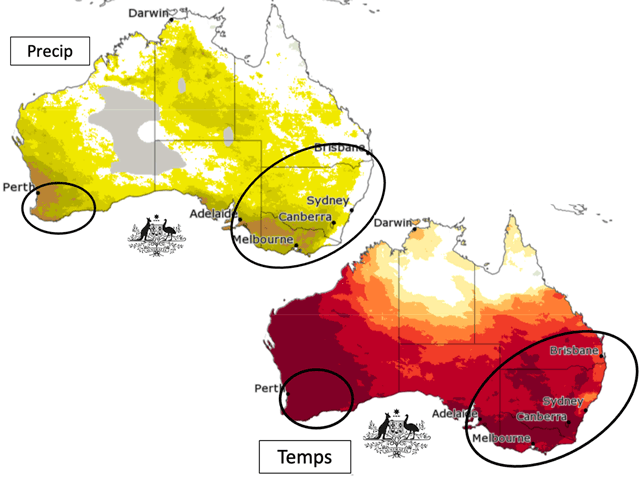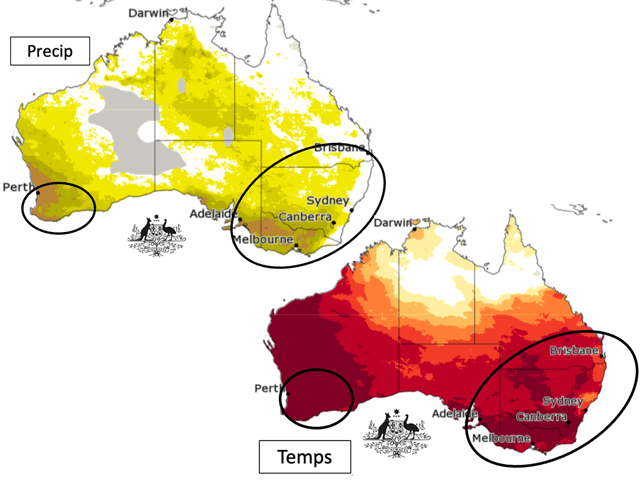Ag Weather Forum
Australia Wheat May Be Challenged by El Nino
As the big Kansas wheat tour takes note of harvest potential for the coming Northern Hemisphere summer, wheat growers in the Southern Hemisphere are finishing up their seeding for wheat that will be harvested near the end of the calendar year. Australia growers are reportedly more than 90% finished with their wheat seeding.
Now, with the wheat in the ground, comes the need for rain and favorable temperatures to bring the wheat through its long growing cycle. Forecasts, though, suggest that the next few months could be stressful to the Australia wheat crop. The Australia Bureau of Meteorology calls for all wheat regions in the country -- Western Australia, New South Wales, southern Queensland, Victoria, and portions of South Australia -- to have more than an 80% probability of the daytime maximum temperatures to be in the top 20% of the historical range during July through September. Along with that warmth, precipitation forecasts are generally below normal, especially in the southern and southeastern wheat areas.
P[L1] D[0x0] M[300x250] OOP[F] ADUNIT[] T[]
A big contributor to this warm and dry outlook is the impact that the developing El Nino in the equatorial Pacific could have on Australia's weather patterns. Pacific Ocean trade winds in an El Nino tend to have a pronounced west-to-east direction. That sweeps moisture toward North and South America but takes it away from Australia. The result is the potential for dryness and drought.
The production years 2020-21, 2021-22 and 2022-23 featured a multiyear La Nina in the equatorial Pacific, and those years were good ones for Australia wheat output. Australia contributed 4.1%, 4.6% and 4.9% -- almost 5% -- to the total world wheat supply in those years, highlighted by a record 39 million metric tons (mmt) harvested in 2022. This year, projections call for a total Australia wheat crop of 29 mmt --- down 26% from last year. As a result, USDA forecasts Australia's share of the world wheat supply to slide to 3.7%.
At this point, most Australia wheat areas have favorable soil moisture to get the newly seeded wheat started. USDA's weekly Weather and Crop Bulletin for the May 14, 2023 time period noted: "Scattered showers maintained local moisture supplies for early winter grain and oilseed development. The heaviest rain (5-15 millimeters) fell across western portions of the Western Australia wheat belt, as well as southern-most parts of southeastern Australia. The rain aided winter crop germination and emergence and likely sparked additional planting in its wake." Still, there will be plenty of concern for the welfare of developing crops if conditions indicated for the wheelhouse of the growing season later this Southern Hemisphere winter/Northern Hemisphere summer indeed develop.
DTN Lead Analyst Todd Hultman contributed to this article.
Bryce Anderson can be reached at Bryce.Anderson@dtn.com
Follow him on Twitter @BAndersonDTN
(c) Copyright 2023 DTN, LLC. All rights reserved.






Comments
To comment, please Log In or Join our Community .